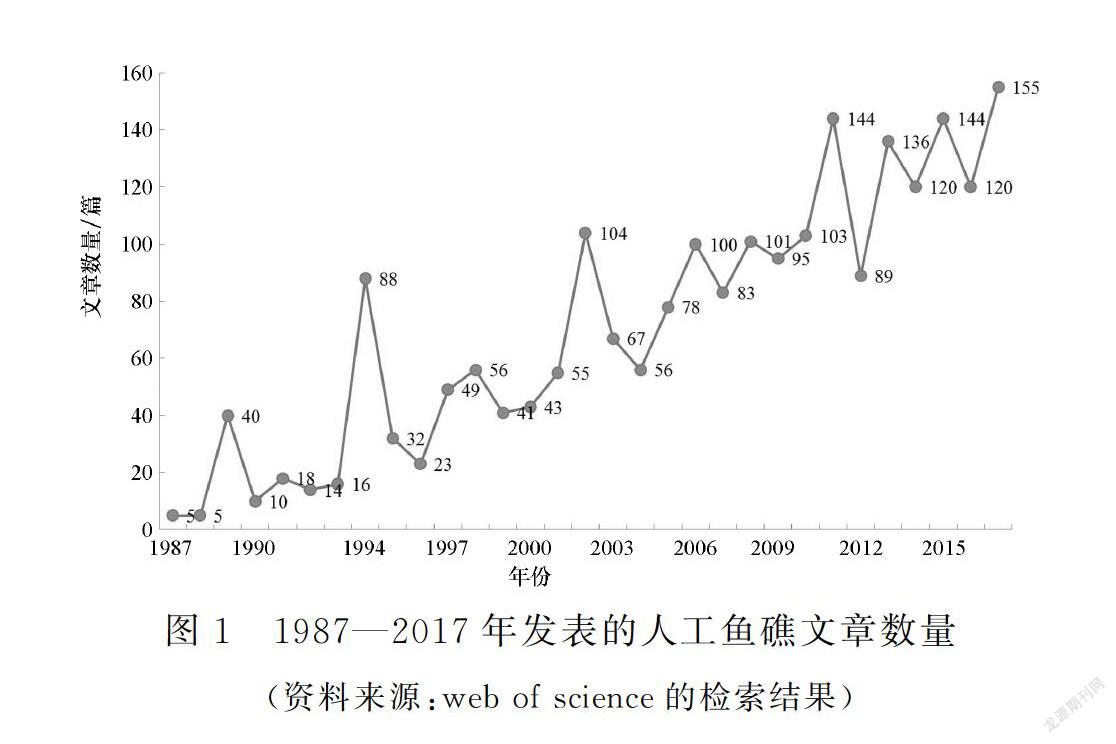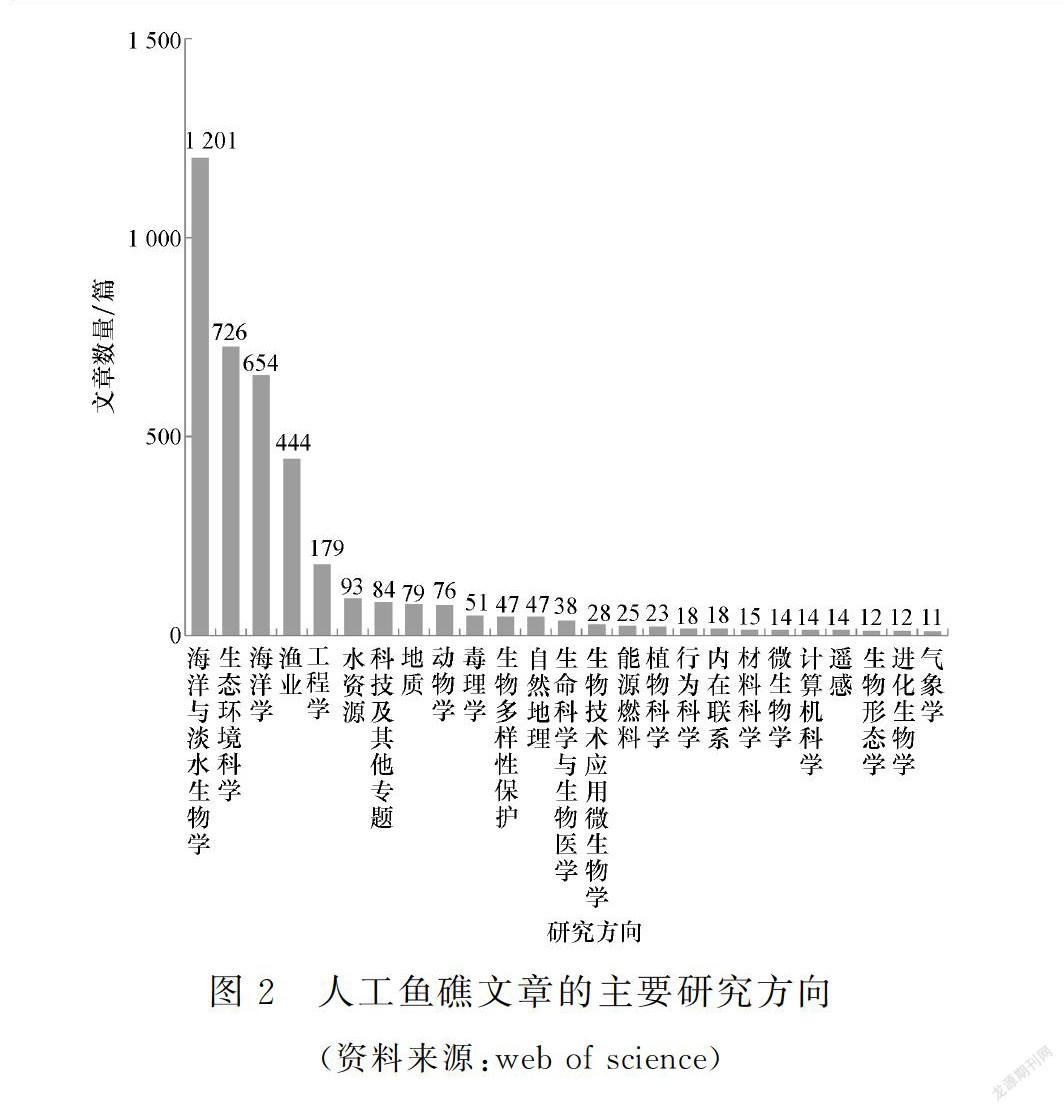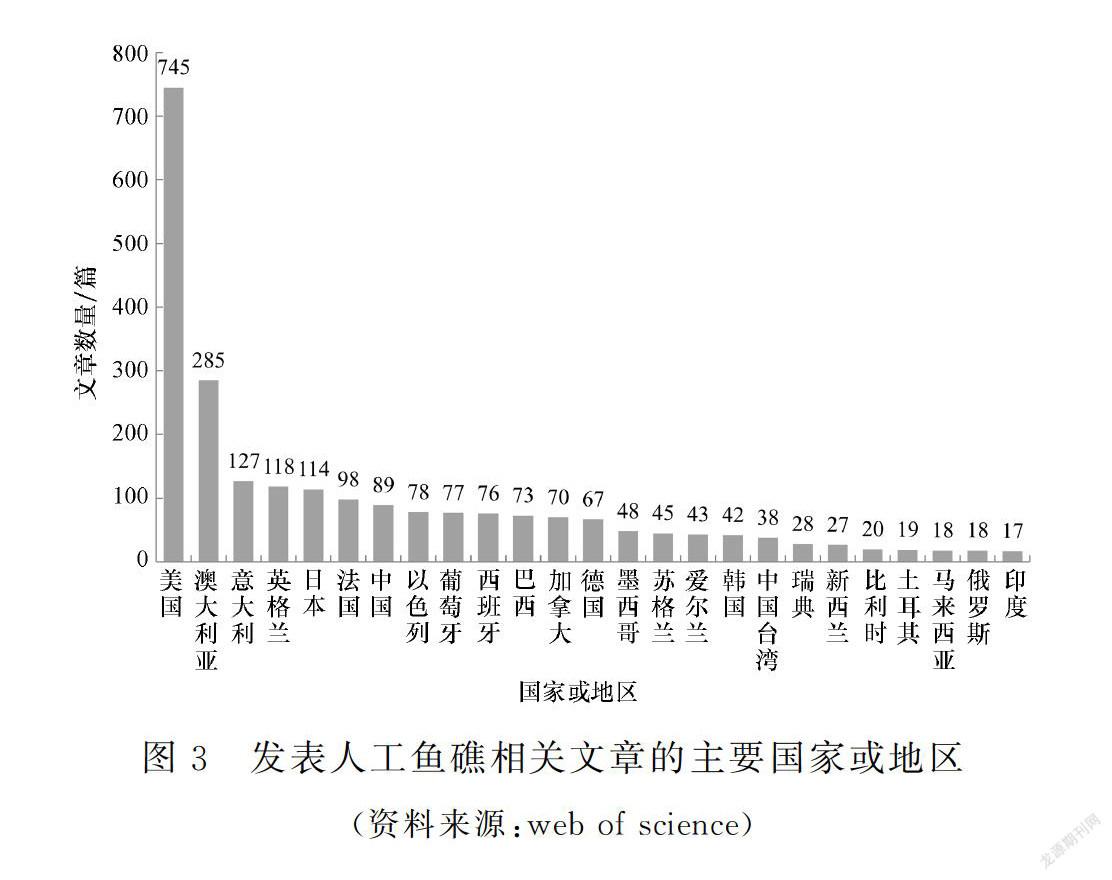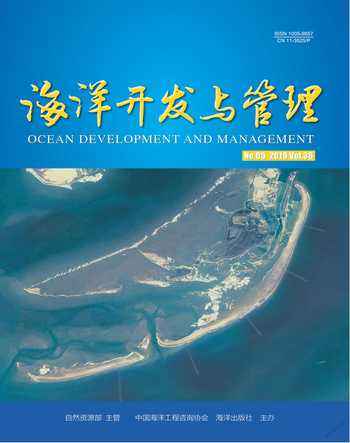国外人工鱼礁研究动向及对我国的启示
杨玉峰 梁浩亮 刘锦荣 刘贵明 李大胜 阮瑞森



摘要:建设人工鱼礁是打造海洋牧场的重要手段之一。文章对1987—2017年的国内外人工鱼礁相关文章进行了梳理,以发表文章数量来划分层次,美国等5个国家为“第一梯队”,而中国等8个国家处于“第二梯队”;2001年之后,中国发表文章的增长率居25个国家首位。国外人工鱼礁的研究主题主要包括鱼礁构建材料、本底调查、设计和布局、环境生态功能、渔业生产和鱼类行为等8个方面。通过总结国外人工鱼礁研究动向的特点,提出科学规划人工鱼礁区、完善资金配套扶持政策、构建人工鱼礁标准体系等3条建议,从而为我国人工鱼礁建设、渔业资源养护、生态环境保护提供参考依据。
关键词:人工鱼礁;设计和管理;渔业资源养护;鱼类行为;环境生态效应;惠州
中图分类号:P74;S9文献标志码:A文章编号:1005-9857(2019)05-0019-07
The Trend of Artificial Reef Research Aboard and Its Enlightenment to China
YANG Yufeng1,LIANG Haoliang1,LIU Jinrong1,LIU Guiming2,LI Dasheng3,RUAN Ruisen4
(1.Marine Technology Center of Huizhou,Huizhou 516000,China;
2.Fisheries Research & Extension Center of Huizhou,Huizhou 516000,China;
3.Guangdong Huayu Engineering Consulting Co.,Ltd,Guangzhou 510610,China;
4.The Guangdong NO.3 Water Conservancy and Hydro-electric Engineering Board Co.,Ltd,Dongguan 523710,China)
Abstract: Artificial reefs construction is one of valuable approaches for marine ranching building.Research papers related to artificial reef,published from 1987 to 2017,were arranged according to the numbers,and the result showed that there were 3 levels for 25 countries and/or areas.Among these 3 levels,5 countries were included in the first echelon (e.g.,USA) and the second echelon comprised 8 countries including China.The growth rate of published papers from China ranked first among 25 countries after 2001.The themes of international artificial reef researches mainly focused on eight aspects,such as reef materials,artificial reef substrates,design and deployment,environmental ecological functions,fisheries production and fish behavior.Summarizing the features of research trends related to artificial reef on abroad,three feasible suggestions were put forward,such as the scientific planning of artificial reef areas,the improvement of financial support policies,and the construction of standard system about artificial reefs.Furthermore,it provided references for artificial reef construction,fishery resources conservation and ecological environment protection in China.
Key words: Artificial reef,Design and management,Fishery resources conservation,Fish behaviors,Environmental ecological effects,Huizhou
0引言
人工鱼礁是放置于海底,具有诱鱼、聚鱼效果,能够保护和修复沿海生态系统的一类构筑物[1]。当前,基于各种目的,如提高渔业生产和管理、保护生物多样性、保护或修复生物栖息地、 建造海底森林、海水养殖、阻止非法捕捞、运动(如潜水)、休闲渔业、海岸带保护、旅游等,世界各国和地区在其沿海建造、投放人工鱼礁[2]。
截至2011年,我国已累计投放人工鱼礁近3 200万m3[3]。随着《广东海洋经济综合试验区发展规划》于2011年经国务院批准,上升为国家级战略,广东打造“海洋经济强省”的“蓝色引擎”就此启动。为将广东海洋经济综合试验区建设成为我国加强海洋生态文明建设的示范区和推进海洋综合管理的先行区,惠州市、珠海市、茂名市申请获批“广东海洋经济综合试验区建设资金大型人工鱼礁示范区建设项目资金”(每市各5 000万元)。本研究作者是“惠州市东山海大型人工鱼礁示范区建设项目”的主持人和主要参与者,通过介绍国内外人工鱼礁的研究动向,综合分析其特点,结合国内的实际情况,为我国人工鱼礁建设、海洋生态环境保护、漁业资源养护提供对策和建议。
1材料与方法
本研究的数据来源于Clarivate Analytics的web of science检索结果。以“artificial reef”为主题,检索1987—2017年的学术文章,得到2 190篇论文(图1)。将2 190篇论文分类、整理,并利用Elsevier等数据库查找部分全文,梳理国内外的人工鱼礁研究动向。
2结果与讨论
2.1研究文章的变化
图1中比较醒目的是,从2002年开始,文章数量出现了一个数量级别的跃升,尤其是2010—2017年,平均每年的文章发表数量达到126篇,这反映出社会各界对人工鱼礁的关注度不断增加。对人工鱼礁的研究,主要集中在海洋与淡水生物学(Marine Freshwater Biology)、生态环境科学(Environmental Sciences Ecology)、海洋学(Oceangraphy)、渔业(Fisheries)等方面(图2)。
1987—2017年的30余年间,有25个国家或地区发表了人工鱼礁的相关研究文章(图3)。按照文章的发表数量划分,美国、澳大利亚、意大利、英格兰、日本等5个国家为“第一梯队”,平均数量为278篇;尤其是美国高达745篇,是第二名澳大利亚(285篇)的2倍多。法国、中国、以色列、葡萄牙、西班牙、巴西、加拿大、德国等8个国家为“第二梯队”,平均数量为79篇。墨西哥、苏格兰、荷兰、韩国、中国台湾、瑞典、新西兰、比利时、土耳其、马来西亚、俄罗斯、印度等12个国家或地区为“第三梯队”,平均数量为31篇。
将2001—2017年的研究数据进行梳理,分两个时间段进行分析:2001—2010年为第1时间段,2011—2017年为第2时间段。美国,第1时间段的平均文章发表数为28篇,第2时间段为37篇,增长率为32%;而澳大利亚的增长率为77%,法国的增长率为162%,中国为248%。这说明,美国人工鱼礁相关研究文章的数量相对在减少,欧洲和亚洲在增多;也反映出越来越多的国家开始实施人工鱼礁工程,意识到人工鱼礁的环境生态友好性和多功能性。
1991年,Grove等[4]展示了1974年、1983年、1987年、1991年国际会议的人工鱼礁研究文章,发现:1974年只有4个国家参加国际会议并发表相关文章,1991年就增加到了25个国家。Baine[5]在2001年对249篇关于人工鱼礁设计、应用、管理、性能的文章摘要进行了分析,指出:38%的摘要来自于北美(尤其是美国),而29%和18%分别来自于欧洲和亚洲(亚洲主要是日本);渔业生态和管理是大家普遍关注的焦点。
2.2研究主题的变化
按照Lee等[2]的相关研究成果,结合国内的人工鱼礁发展现状,本研究分8个方面介绍人工鱼礁研究主题的变化。
2.2.1人工鱼礁的材料
从1987年开始,关于人工鱼礁主要构建材料的研究逐渐减少[2]。在20世纪90年代,Pickering[1]研究了烟气脱硫装置作为人工鱼礁构建材料的适宜性,发现其在物理、环境、法律等方面皆符合要求。进入21世纪,Kim等[6]研究了韩国近岸海域礁体加固对环境的影响,发现:加固后的混凝土礁体具有更佳的化学特性,能够延长服务周期。
近年来,Chen等[7]提出用硫酸铝盐水泥、海砂、海水搅拌混合作为一种新的人工鱼礁混凝土材料,实验证实其机械特性、黏合力具有可行性。Huang等[8]则发明了一种人工鱼礁混凝土绿色产品,主要原材料包括废弃的工业炉渣、铁渣、烟气脱硫的石膏等,其适于海藻附着、生长。Liu等[9]研究了某种人工鱼礁外壳对海底大型无脊椎动物的影响,发现人工鱼礁外壳能够显著集聚大型底栖生物,提高临海海域的环境质量,可以作为恢复海洋生物栖息地的有效手段之一。
2.2.2人工鱼礁的本底调查
关于人工鱼礁本底调查的文章较少[2]。Santos等[10]指出,与自然鱼礁相比,人工鱼礁能够丰富渔业资源的种类,提高渔获量;Pickering等[11]则研究了人工鱼礁数量对聚鱼效果的影响。Smith等[12]研究了近岸浅水区人工鱼礁区域和对照区域中无脊椎动物群落的差异性。Atilla等[13]则发现,防波堤附近的小型底栖生物比沉积物自身聚集的更丰富。
2.2.3流场和稳定性
近10年来,人工鱼礁周边的流场及人工鱼礁稳定性的研究较多[2]。Miao等[14]通过模拟海浪,分析了水深对人工鱼礁周围水动力的影响,结果显示:当水深变浅,则水动力长期赋值增加。Düzbastilar等[15]则研究了海浪与人工鱼礁的相互作用。Liu等[16]开发了一种三维数值模型,计算星型人工鱼礁周围流场的不稳定性。Woo等[17]则开发了一种新方法以评估人工鱼礁的曳引系数。Yoon等[18]利用3种体积系数,开发了一种成本-收益方法,用以评估人工鱼礁的状态。
2.2.4设计、布局和性能
自2000年之后,关于人工鱼礁设计、布局和性能的研究逐渐增多[2]。Lan等[19]通过构建一种数学模型和运算程序,开发了一种新的技術手段,用以设计人工鱼礁生态系统的空间布局。随后,Lan等[20]开发了一种更复杂的程序,以精确地描述鱼礁布局单元的结构类型,从而创造自然地形下的人工栖息地。Ng等[21]证明了如何制订多功能人工鱼礁的最佳设计标准。Walles等[22]则发现人工鱼礁能够为牡蛎附着提供基础条件,从而促进鱼礁的形成;然而当地的沉积作用和潮汐运动则阻碍了鱼礁的发育。
2.2.5渔业生产、提高和生产力
随着社会的发展,人工鱼礁对渔业生产或生产力的影响受到社会各界的更多关注[2]。20世纪80年代后,Polovina等[23]发现人工鱼礁导致日本海域某种章鱼的产量提高;Bohnsack[24]也明确指出,理论上人工鱼礁可以提高区域鱼类生物量,而生物生境是一个限制因素。Bortone等[25]认为,人工鱼礁可以创造一种独特生物生境,提高了环境营养物质的供给,从而改善了人工鱼礁区域动植物的种类组成和丰度。Pickering等[26]探讨了人工鱼礁作为海岸生态系统修复工具的可行性。
21世纪以来,Langlois等[27]研究了人工鱼礁距离与一种大型动物群落结构变异性的关系。Whitmarsh等[28]分析了人工鱼礁对近岸海域渔场的支撑作用。Cresson等[29]对人工鱼礁区域内23种鱼类的渔获量进行了调查,以评估其营养级和饲喂习性;结果发现,人工鱼礁区域与自然环境有很大不同。Islam等[30]指出,渔民在人工鱼礁区域的养殖收入明显比非人工鱼礁区域高。Yu等[31]研究发现,人工鱼礁能够提高自游生物的生物量。Lv等[32]的研究结果显示,水体盐度和底质因素是影响人工鱼礁区大型底栖动物分布的主要因素。
2.2.6人工鱼礁的物理、生态功能
对人工鱼礁的物理和生态功能的研究主要从2010年开始[2]。Santos等[33]研究发现,距离人工鱼礁越近,则鱼类丰富度和多样性就会提高。Campbell等[34]指出,人工鱼礁数量的增多一般会提高生物量,故人工鱼礁的管理政策必须考虑鱼礁的数量和空间布局。Liu等[35]则发现,由于海洋保护区内投放了人工鱼礁,故保护区内外的小型动物群落有明顯的差异。Rendle等[36]调查了人工鱼礁对当地经济的贡献,发现人工鱼礁作为滨海旅游的亮点,其对当地经济发展具有持久的推动性。López等[37]在综合分析气候、生物群落、沉积运动、海岸带演变等多种因素的基础上,设计了多功能型人工鱼礁。Layman等[38]指出,在评价人工鱼礁的吸引-产出模式时,需要重点考虑生态系统的作用。
2.2.7人工鱼礁区的环境生态效应
2008年之前,关于人工鱼礁区环境生态效应的研究文章较少,此后急剧增加[2]。 Erftemeijer等[39]调查了人工鱼礁区的温度、深度、盐度、水动力、浊度等环境因子,研究了这些环境因子对人工鱼礁聚鱼效果的影响。Faverney等[40]利用贻贝研究了轮胎材质的人工鱼礁的潜在毒性。Hackradt等[41]研究发现,随着礁区面积和礁体孔洞数量的增加,鱼类丰富度和多样性随之提高;而且,自然鱼礁和人工鱼礁区的鱼类组成、营养层级和结构明显不同。Simon等[42]则证实了人工鱼礁对特定鱼类的吸引和集聚效果。
近年来,Mohd等[43]研究发现,在3年时间内,人工鱼礁区海洋动物群落覆盖度平均达到17%。Spagnolo等[44]探讨了不同人工鱼礁材质和形状的聚鱼效果。Yamamoto等[45]指出,人工鱼礁投放布局的复杂性,导致鱼群组成的差异性。Zalmon等[46]评估了人工鱼礁空间布局对动物群落结构的影响。Oricchio等[47]研究发现,船坞区和防波堤附近的动物群落结构存在明显差异。Noh等[48]研究了特定人工鱼礁环境的指示物种,发现水温的季节变化对鱼类营养层级的影响最大。Xu等[49]则调查了人工鱼礁区中流动生物的功能群和食物源。
2.2.8人工鱼礁周边的鱼类行为特性
30年来,对人工鱼礁应用引发的重要经济鱼类行为特性的研究较少[2]。Topping等[50]指出,人工鱼礁是墨西哥湾红甲鱼(Lutjanus campechanus)的重要栖息地,其夜间离人工鱼礁较远,白天则反之。Henderson等[51]调查了人工鱼礁区夏季比目鱼的分布和运动特性。Hoey等[52]比较了75个鱼礁附近鹦嘴鱼的分布和生态系统功能,发现其与当地环境条件密切相关。
3国外人工鱼礁研究动向的特点
综合分析30余年来国外人工鱼礁的研究动向,其具有以下7个特点[2]:
①近10年来,人工鱼礁相关研究的范围显著扩大。
②人工鱼礁设计、布局、管理等技术的提高,使得人们更关注于渔业资源养护方面。
③人工鱼礁的关注点逐渐从提高渔获量,转移至改善海洋生态系统结构。
④开发环境友好型的人工鱼礁构建材料,引起社会各界的兴趣。
⑤对人工鱼礁周边水动力、流场的研究逐渐增多,以期增大人工鱼礁的生态功能,提高人工上升流的营养盐供给。
⑥利用远程鱼类聚集探测系统来研究鱼类行为特性,从而有效管理人工鱼礁周边的重要经济鱼类。
⑦通过开发计算机运行程序,以确定人工鱼礁的投放区域和周边环境,这凸显出人工鱼礁建设的重要性和科学性。
4对我国人工鱼礁建设的启示
我国当前已有《人工鱼礁建设技术规范》(SC/T 9416—2014)、《人工鱼礁资源养护效果评价技术规范》(SC/T 9417—2015)和《人工鱼礁建设项目管理细则》(农办渔〔2018〕66号)等标准和法规文件,指导全国的人工鱼礁建设,同时,人工鱼礁的相关研究发展迅速[53-55],但是整体起步较晚,系统性的研究有待进一步提高。因此,为提高人工鱼礁的生态、环境和经济效果,提出如下建议。
4.1以目标为引领,科学规划人工鱼礁区建设
人工鱼礁是建设海洋牧场的重要手段之一,其目的是改善海洋生态环境、恢复渔业资源。以此目标为引领,在充分开展海洋环境生态调查评价和渔业资源调查的基础上,结合当地的财力、物力和海域承载能力等客观条件,从人工鱼礁的选址适宜性评价、设计和空间布局、建造和投放资金、环境生态效应、后期管理等多个方面出发,科学规划人工鱼礁的中长期建设。
4.2以问题为导向,完善资金配套扶持政策
“两山论”是习近平总书记关于生态环境保护的重要论断之一。“绿水青山就是金山银山”,针对人工鱼礁区的经济效益,建议“政府搭台、企业唱戏”。通过出台相关的政策文件,如自然资源部、中国工商银行联合印发的《关于促进海洋经济高质量发展的实施意见》,鼓励、吸引企业加入人工鱼礁区的建设队伍中,因地制宜,发展休闲渔业和滨海旅游业,提高人工鱼礁的经济效益,促进传统渔业向现代渔业转变,推动海洋经济由高速度增长向高质量发展转变。
4.3以科研为基础,构建人工鱼礁标准体系
中国是海洋大国,海岸线长,海域面积大,各省、市、自治区建设人工鱼礁的依据尺度不统一。建议在人工鱼礁区的海洋环境生态调查评价方面,以海洋环境主管部门的数据为标准;在渔业资源调查评价方面,以海洋渔业行业内资深科研院所的调查结果为标准。同时,以高校或科研院所的科研结果为基础,开展人工鱼礁环境生态、渔业资源等多方面绩效目标的评价标准研究。从而,构建人工鱼礁标准体系。
参考文献
[1]PICKERING H.Artificial reefs of bulk waste materials:a scientific and legal review of the suitability of using the cement stabilised by-products of coal-fired power stations[J].Marine Policy,1996,20 (6):483-497.
[2]LEE M O,OTAKE S,KIM J K.Transition of artificial reefs (ARs) research and its prospects[J].Ocean and Coastal Management,2018,154:55-65.
[3]曾旭,章守宇,林軍,等.岛礁海域保护型人工鱼礁选址适宜性评价[J].水产学报,2018,42(5):673-683.
[4]GROVE R S,SONU C J.Artificial habitat technology in the world-today and tomorrow[C]//Tokyo:In:Proc.Japan-US on Artificial Habitats for Fisheries,1991:3-9.
[5]BAINE M.Artificial reefs:a review of their design,application,management and performance[J].Ocean and Coastal Management,2001,44(3):241-259.
[6]KIM H S,KIM C G,NA W B,et al.Chemical degradation characteristics of reinforced concrete reefs in South Korea[J].Ocean Engineering,2008,35(8):738-748.
[7]CHEN C,JI T,ZHUANG Y,et al.Workability,mechanical properties and affinity of artificial reef concrete[J].Construction & Building Materials,2015,98:227-236.
[8]HUANG X,WANG Z,LIU Y,et al.On the use of blast furnace slag and steel slag in the preparation of green artificial reef concrete[J].Construction & Building Materials,2016,112:241-246.
[9]LIU G,LI W T,ZHANG X.Assessment of the benthic macrofauna in an artificial shell reef zone in Shuangdao Bay,Yellow Sea[J].Marine Pollution Bulletin,2016,114(2):778-785.
[10]SANTOS M N,MONTEIRO C C.The Olho artificial reef system (south Portugal):Fish assemblages and fishing yield[J].Fisheries Research,1997,30(1-2):33-41.
[11]PICKERING H,WHITMARSH D.Artificial reefs and fisheries exploitation:a review of the ‘attraction versus production’ debate,the influence of design and its significance for policy[J].Fisheries Research,1997,31(1-2):39-59.
[12]SMITH S D A,RULE M J.Artificial substrata in a shallow sublittoral habitat:do they adequately represent natural habitats or the local species pool?[J].Journal of Experimental Marine Biology & Ecology,2002,277(1):25-41.
[13]ATILLA N,WETZEL M A,FLEEGER J W.Abundance and colonization potential of artificial hard substrate-associated meiofauna[J].Journal of Experimental Marine Biology & Ecology,2003,287(2):273-287.
[14]MIAO Z Q,XIE Y H.Effects of water-depth on hydrodynamic force of artificial reef[J].Journal of Hydrodynamics,2007,19(3):372-377.
[15]D ZBASTLLAR F O,ENT RK U.Determining the weights of two types of artificial reefs required to resist wave action in different water depths and bottom slopes[J].Ocean Engineering,2009,36(12):900-913.
[16]LIU Y,ZHAO Y P,DONG G H,et al.A study of the flow field characteristics around star-shaped artificial reefs[J].Journal of Fluids & Structures,2013,39(5):27-40.
[17]WOO J,KIM D,YOON H S,et al.Characterizing Korean general artificial reefs by drag coefficients[J].Ocean Engineering,2014,82(10):105-114.
[18]YOON H S,KIM D,NA W B.Estimation of effective usable and burial volumes of artificial reefs and the prediction of cost-effective management[J].Ocean & Coastal Management,2016,120:135-147.
[19]LAN C H,CHEN C C,HSUI C Y.An approach to design spatial configuration of artificial reef ecosystem[J].Ecological Engineering,2004,22(4):217-226.
[20]LAN C H,LAN K T,HSUI C Y.Application of fractals:create an artificial habitat with several small (SS) strategy in marine environment[J].Ecological Engineering,2008,32(1):44-51.
[21]NG K,PHILLIPS M R,CALADO H,et al.Seeking harmony in coastal development for small islands:exploring multifunctional artificial reefs for So Miguel Island,the Azores[J].Applied Geography,2013,44:99-111.
[22]WALLES B,TROOST K,ENDE D V D,et al.From artificial structures to self-sustaining oyster reefs[J].Journal of Sea Research,2016,108:1-9.
[23]POLOVINA J J,SAKAI I.Impacts of Artificial Reefs on Fishery Production in Shimamaki,Japan[J].Bulletin of Marine Science,1989,44(2):997-1003.
[24]BOHNSACK J A.Are High Densities of Fishes at Artificial Reefs the Result of Habitat Limitation or Behavioral Preference?[J].Bulletin of Marine Science,1989,44(2):631-645.
[25]BORTONE S A,MARTIN T,BUNDRICK C M.Factors Affecting Fish Assemblage Development on a Modular Artificial Reef in a Northern Gulf of Mexico Estuary[J].Bulletin of Marine Science,1994,55(2-3):319-332.
[26]PICKERING H,WHITMARSH D,JENSEN A.Artificial Reefs as a Tool to Aid Rehabilitation of Coastal Ecosystems:Investigating the Potential[J].Marine Pollution Bulletin,1999,37(8-12):505-514.
[27]LANGLOIS T J,ANDERSON M J,BABCOCK R C.Inconsistent effects of reefs on different size classes of macrofauna in adjacent sand habitats[J].Journal of Experimental Marine Biology & Ecology,2006,334(2):269-282.
[28]WHITMARSH D,SANTOS M N,RAMOS J,et al.Marine habitat modification through artificial reefs off the Algarve (southern Portugal):An economic analysis of the fisheries and the prospects for management[J].Ocean & Coastal Management,2008,51(6):463-468.
[29]CRESSON P,RUITTON S,OURGAUD M,et al.Contrasting perception of fish trophic level from stomach content and stable isotope analyses:A Mediterranean artificial reef experience[J].Journal of Experimental Marine Biology & Ecology,2014,452(2):54-62.
[30]ISLAM G M N,NOH K M,SIDIQUE S F,et al.Economic impact of artificial reefs:A case study of small scale fishers in Terengganu,Peninsular Malaysia[J].Fisheries Research,2014,151(3):122-129.
[31]YU J,CHEN P,TANG D,et al.Ecological effects of artificial reefs in Daya Bay of China observed from satellite and in situ,measurements[J].Advances in Space Research,2015,55(9):2315-2324.
[32]LV W,HUANG Y,LIU Z,et al.Application of macrobenthic diversity to estimate ecological health of artificial oyster reef in Yangtze Estuary,China[J].Marine Pollution Bulletin,2016,103(1-2):137-143.
[33]SANTOS L N D,BROTTO D S,ZALMON I R.Fish responses to increasing distance from artificial reefs on the Southeastern Brazilian Coast[J].Journal of Experimental Marine Biology & Ecology,2010,386(1):54-60.
[34]CAMPBELL M D,ROSE K,BOSWELL K,et al.Individual-based modeling of an artificial reef fish community:Effects of habitat quantity and degree of refuge[J].Ecological Modelling,2011,222(23):3895-3909.
[35]LIU X S,XU W Z,CHEUNG S G,et al.Response of meiofaunal community with special reference to nematodes upon deployment of artificial reefs and cessation of bottom trawling in subtropical waters,Hong Kong[J].Marine Pollution Bulletin,2011,63(5-12):376-384.
[36]RENDLE E J,RODWELL L D.Artificial surf reefs:A preliminary assessment of the potential to enhance a coastal economy[J].Marine Policy,2014,45(1):349-358.
[37]LPEZ I,TINOCO H,ARAGONS L,et al.The multifunctional artificial reef and its role in the defence of the Mediterranean coast[J].Science of the Total Environment,2016,550:910-923.
[38]LAYMAN C A,ALLGEIER J E,MONTAA C G.Mechanistic evidence of enhanced production on artificial reefs:A case study in a Bahamian seagrass ecosystem[J].Ecological Engineering,2016,95:574-579.
[39]ERFTEMEIJER P,DEGRAAFF R,BOOT G.Site-Selection for Artificial Reefs in Bahrain Based on GIS-Technology and Hydrodynamic Modelling[J].Journal of Marine Science and Environment,2004,C2:29-38.
[40]FAVERNEY R D,GUIBBOLINI-SABATIER M E,FRANCOUR P.An ecotoxicological approach with transplanted mussels (Mytilus galloprovincialis) for assessing the impact of tyre reefs immersed along the NW Mediterranean Sea[J].Marine Environmental Research,2010,70(1):87-94.
[41]HACKRADT C W,FLIXHACKRADT F C,GARCACHA-RTON J A.Influence of habitat structure on fish assemblage of an artificial reef in southern Brazil[J].Marine Environmental Research,2011,72(5):235-247.
[42]SIMON T,PINHEIRO H T,JOYEUX J C.Target fishes on artificial reefs:Evidences of impacts over nearby natural environments[J].Science of the Total Environment,2011,409(21):4579-4584.
[43]MOHD F M,ANG S Y,SAIFUL B H,et al.Colonization of Marine Epibiota around WABCORE Artificial Reef at Panuba Bay,Tioman Island,Malaysia[C]// Dubai:International Conference on Environmental Science and Development.2013:416-422.
[44]SPAGNOLO A,CUICCHI C,PUNZO E,et al.Patterns of colonization and succession of benthic assemblages in two artificial substrates[J].Journal of Sea Research,2014,88:78-86.
[45]YAMAMOTO K C,FREITAS C E D C,ZUANON J,et al.Fish diversity and species composition in small-scale artificial reefs in Amazonian floodplain lakes:Refugia for rare species?[J].Ecological Engineering,2014,67(6):165-170.
[46]ZALMON I R,S F S D,NETO E J D,et al.Impacts of artificial reef spatial configuration on infaunal community structure-Southeastern Brazil[J].Journal of Experimental Marine Biology & Ecology,2014,454(5):9-17.
[47]ORICCHIO F T,PASTRO G,VIEIRA E A,et al.Distinct community dynamics at two artificial habitats in a recreational marina[J].Marine Environmental Research,2016,122:85.
[48]NOH J,RYU J,LEE D,et al.Distribution characteristics of the fish assemblages to varying environmental conditions in artificial reefs of the Jeju Island,Korea.[J].Marine Pollution Bulletin,2017,118(1-2):388-396.
[49]XU Q,ZHANG L,ZHANG T,et al.Functional groupings and food web of an artificial reef used for sea cucumber aquaculture in northern China[J].Journal of Sea Research,2017,119:1-7.
[50]TOPPING D T,SZEDLMAYER S T.Home range and movement patterns of red snapper (Lutjanus campechanus) on artificial reefs[J].Fisheries Research,2011,112(1):77-84.
[51]HENDERSON M J,FABRIZIO M C,LUCY J A.Movement patterns of summer flounder near an artificial reef:Effects of fish size and environmental cues[J].Fisheries Research,2014,153(5):1-8.
[52]HOEY A S,FEARY D A,BURT J A,et al.Regional variation in the structure and function of parrotfishes on Arabian reefs.[J].Marine Pollution Bulletin,2016,105(2):524-531.
[53]劉鸿雁,吕洪斌,张沛东,等.人工鱼礁模型和大型海藻对许氏平鲉和大泷六线鱼幼鱼的诱集作用[J].水产学报,2018,42(1):48-59.
[54]王亮根,李亚芳,杜飞雁,等.大亚湾人工鱼礁区和岛礁区浮游动物群落特征及对仔稚鱼的影响[J].南方水产科学,2018,14(2):41-50.
[55]曾旭,章守宇,林军,等.岛礁海域保护型人工鱼礁选址适宜性评价[J].水产学报,2018,42(5):673-683.

